What is a Twill Trench Coat? Origin, Design & Fabrics
So, what is a twill trench coat? A twill trench coat is a sophisticated variation of the classic trench coat, crafted from cotton twill—a tightly woven fabric recognised for its diagonal weave, durability, and subtle, elegant texture. In contrast to traditional gabardine trench coats, twill versions often feel slightly softer, drape more fluidly, and offer a modernised, polished silhouette that retains all the hallmarks of the original design.
The trench coat itself stands as a symbol of refined elegance in luxury fashion, with deep roots in military history and utilitarian innovation. Twill trench coats preserve the defining elements of their wartime predecessors—double-breasted fronts, epaulettes, storm flaps, and belted waists—but reinterpret them through a fabric that emphasises tactile richness and versatility.
In this guide, we will explore how this iconic outerwear garment emerged from the battlefields of World War I to become a fashion mainstay. Discover how British heritage brands like Burberry and Aquascutum helped define its legacy, and explore the key differences between twill and gabardine trench coats. Gain insights into the craftsmanship and fabrics that continue to shape thus enduring type of luxury coats.
Twill vs Gabardine

What is cotton twill?
Classic twill refers simply to the weaving method of any fabric whereby the threads cross over and under each other in a diagonal pattern. Ordinary cotton twill fabrics can be loose or tight, thick or thin, depending on their purpose. Regular cotton twill can be casual, rugged, or coarse. For example, chino and denim jeans use a form of mid- to heavyweight cotton twill pictured above.
Meanwhile, trench coat twill, like that in the example from Ralph Lauren pictured below, is also a cotton twill. However, trench coat twill tends to be tightly woven, finer and smoother in texture, more lightweight, and is often treated for water resistance.
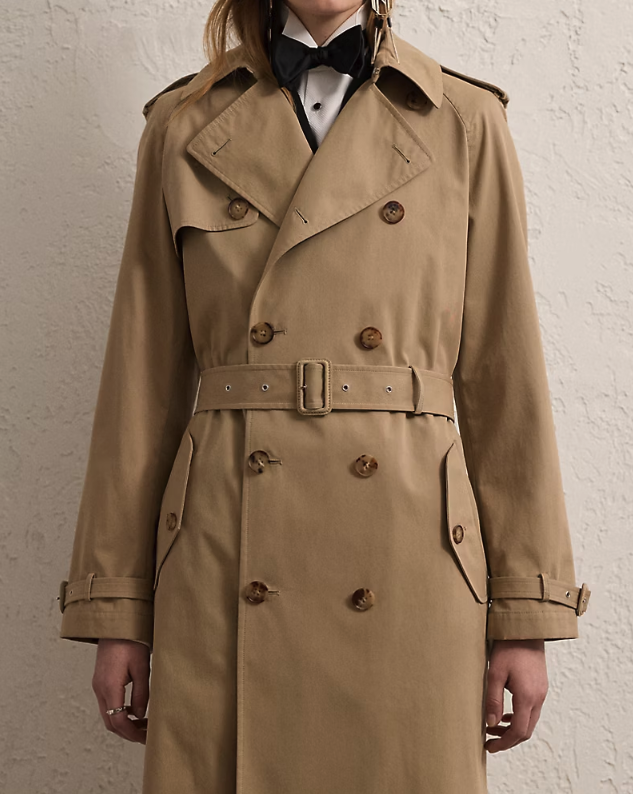
What is a cotton twill coat?
A twill coat refers to outerwear crafted from fabric woven in the abovementioned twill pattern. This weave lends the fabric strength, fluid drape, and a natural resistance to wrinkles. Unlike flat-weave fabrics, where threads interlace in a simple crisscross, twill weave creates a denser, more textural surface with greater visual depth and flexibility. Therefore, twill is exceptionally well-suited for trench coats and tailored outerwear for enhanced structure without rigidity.
A twill trench coat is typically made from cotton twill, wool twill, or polyester-blend twill. Cotton twill offers a crisp yet breathable texture, whilst wool twill provides additional warmth and a softer, more luxurious handfeel.
What is gabardine?
Gabardine is always a twill weave, typically crafted with Egyptian cotton or worsted wool. Though, it is nevertheless a luxurious, technical refinement of the standard twill structure. Gabardine is a specific type of densely woven twill weave, developed with a weather-resistant finish.
Particularly, gabardine typically has a steeper twill angle (around 63 degrees vs the typical 45 degrees seen in standard twills). The warp yarns (the vertical ones) are made extra tightly twisted before weaving, adding firmness and smoothness. In fact, they are woven so densely that water droplets bead off the surface. Yet, the fabric still allows air to pass through, making it breathable, unlike waxed or rubberised coats of the time. Additionally, classic Burberry gabardine is made with long-staple cotton fibres (finer, stronger fibres) which also contribute to its smooth, durable surface.
Thus, this unique innovation by Burberry marked a pivotal moment in outerwear design.
Why Is It Called a ‘Trench’ Coat?
The trench coat was born on the battlefield. Its origin dates back to World War I, around 1914, when the coat was designed for the British military. It took its name directly from the battlefield trenches of the European theatre. Specifically, British officers needed a lighter alternative to the heavy wool greatcoats traditionally worn for warmth in the 19th century. The greatcoat was bulky, weighty, soaked easily in the rain, and was wholly impractical in combat.
Therefore, a new design was required. One that could shield against wind, rain, and mud while allowing ease of movement. Thus, the trench coat emerged—functional, weather-resistant, and sharply structured.
The trench coat’s wartime use began around 1914. However, the intellectual and technical groundwork had already been laid in the decades prior by two competing British heritage brands: Aquascutum and Burberry.
Who Invented the Trench Coat? Trench Coat Origin
Both brands—Aquascutum, founded in 1851, and Burberry, established in 1856—claim to have created the original trench coat. While each made significant contributions to its evolution, an ealier individual invented a raincoat fabric decades prior.
Charles Mackintosh Coat: Early Waterproof Outerwear Before the Trench Coat
Before the trench coat as we know it existed, outerwear innovation began with Charles Macintosh. Charles was a Scottish chemist who, in the 1820s, invented a waterproof fabric by sandwiching rubber between two layers of cloth. This led to the creation of the “mackintosh” coat—an early raincoat ideal for civilian wear. Alas, the fabric was ill-suited for active movement. The rubber made it stiff, poorly ventilated, and prone to melting in heat.

Aquascutum Coat
In 1853, British tailoring company Aquascutum (“aqua” = water, “scutum” = shield) developed a water-repellent wool fabric. They began producing raincoats for British officers as early as the Crimean War. Although not yet called a “trench coat,” it served a similar military function. Aquascutum’s raincoats at the time were not made of cotton twill, but rather wool or treated cotton.
Whilst both Aquascutum and Burberry supplied to the British military, Aquascutum focused more on officers’ raincoats and less on the full trench coat style that Burberry perfected. The former’s coats were known for their traditional, tailored drape and formal elegance, whilst Burberry innovated specifically for battlefield needs.
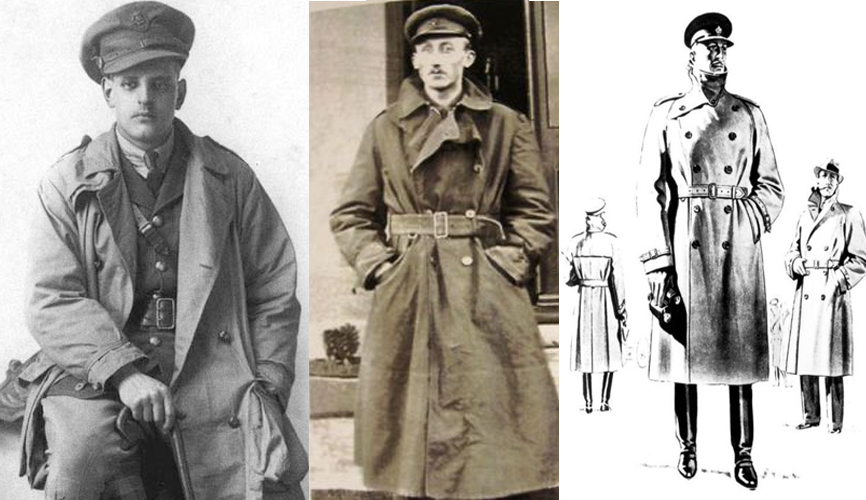
Burberry Trench Coat: What Fabric Is a Burberry Trench Coat?
The story of the modern trench coat cannot be told without Burberry trench coats and their innovative gabardine twill fabric. Originally, twill weave was a diagonal ribbed weaving structure. This weave type had existed since prior to medieval times in textiles. Though, the medieval term ‘gabardine’ referred to a type of long, loose cloak.
However, in 1879, Thomas Burberry repurposed the old term gabardine to patent a form of tightly woven, durable, and water-resistant cotton twill. It proposed a practical alternative to the stiff and heavy fabrics at the time that were treated with oil or wax to achieve water resistance for military rain capes, for example. Meanwhile, Burberry’s gabardine twill was revolutionary because in the era before the invention of synthetic material, it was water-resistant naturally through its weave and treatment without the need for heavy wax coatings. Therefore, the fabric remained lightweight, breathable, and was far more comfortable.
Burberry quickly became the preferred supplier of coats to British and Allied officers during World War I. This was due to superior quality and weather protection.
Interestingly, British officers in WWI were not issued trench coats by the military, but were expected to purchase them privately. No exclusive government contract was granted—likely because trench coats were considered an optional, officer-only item rather than standard issue.
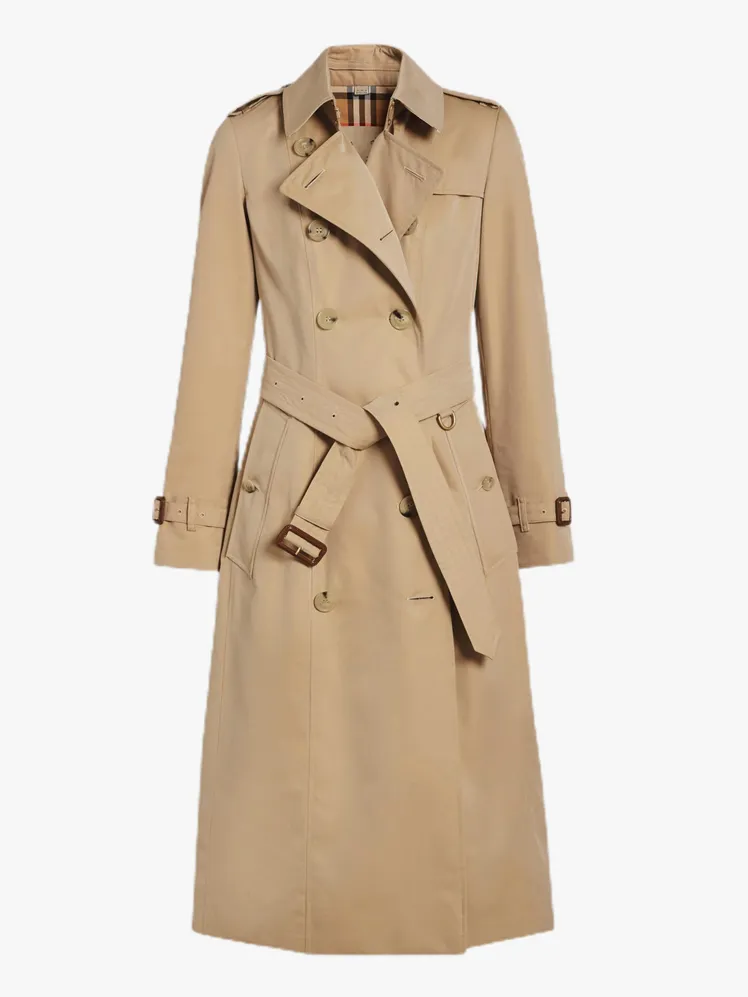
Iconic Features of the Original Burberry Trench Coat
These coats featured a number of now-iconic design refinements for various military purposes.
- Epaulets: Functional shoulder straps designed to secure items such as gloves, whistles, or military equipment, and to display rank insignia;
- Storm Flap: A protective extra layer of fabric over the chest and back to prevent rain from seeping through the seams during heavy downpours;
- Belt with D-Rings: A structured waist belt fitted with durable metal D-rings intended for carrying equipment like map cases or swords, reflecting the trench coat’s utilitarian military roots;
- Belt with D-Rings: A structured waist belt fitted with durable metal D-rings intended for carrying equipment like map cases or swords, reflecting the trench coat’s utilitarian military roots;
- Vented Back: A rear pleat or vent that allowed greater ease of movement—essential for officers who needed agility in combat or on horseback; and
- Removable Wool Lining: for added warmth during colder campaigns, ensuring the coat’s versatility across changing seasons; and
- Sleeve straps or cuff straps: Originally used by soldiers to tighten the sleeve openings to keep out rain, wind, or gas during WWI;
- Chin strap, throat latch, or storm collar tab: used to fasten the collar across the throat when it is turned up, shielding the neck from wind and rain.
Over time, the silhouette and functionality of Burberry’s trench became the blueprint for the modern trench coat silhouette we recognise today. In fact, gabardine is woven to this day in Burberry’s own Yorkshire mill, showcasing how the fabric remains timeless and central to the brand’s heritage.
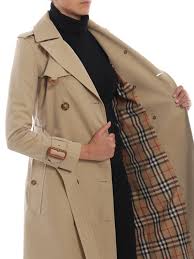
The Lining of the Burberry Trench Coat
Originally, Burberry trench coats featured a full or partial lining, typically crafted from lightweight cotton to enhance breathability while maintaining structure. Early versions did not yet display the now-famous Burberry check. It was in the 1920s that Burberry introduced its signature Burberry Check—a camel, black, red, and white tartan—as a lining, first used to distinguish authentic Burberry garments. This iconic pattern became synonymous with British refinement and understated luxury.
Over time, as trench coats adapted to women’s fashion, linings were often tailored for a softer drape. Variations like silk-blend linings appeared in more elegant, fashion-forward interpretations. Interestingly, the evolution of the trench lining perfectly mirrors the coat’s transition from a purely functional military garment to a symbol of enduring style.
What Makes a ‘Trench Coat’ a Trench Coat?
To answer what is a twill trench coat, we must first consider the foundation: the classic trench coat, as defined by early 20th-century British outerwear – most iconically by Burberry.
The traditional trench coat is a long, double-breasted coat, crafted for both structure and function. often belted at the waist and designed with a storm flap, epaulets, and a back vent. It typically extends to the knee or lower thigh.
The trench coat’s most notable features described below served purposes relating to durability, weather protection, and military utility during World War I.
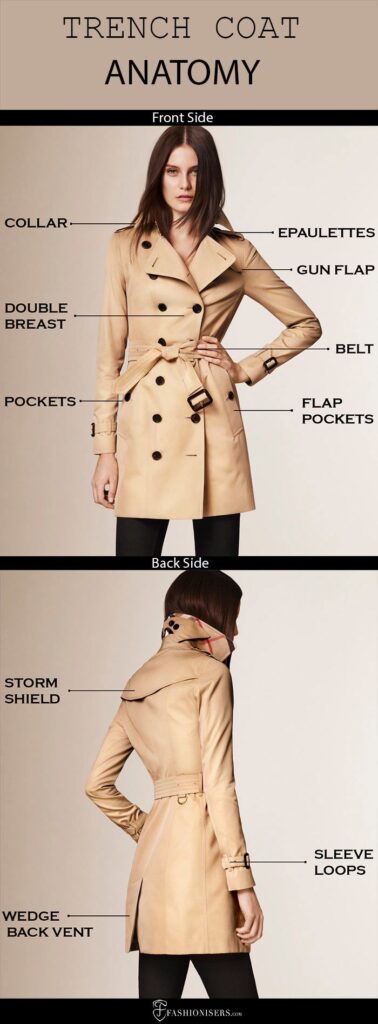
- Epaulets: Shoulder tabs originally for military insignia to display rank.
- Storm flap: An additional, protective panel over the chest to protect against rain.
- Gun flap: Reinforced shoulder section to shield from water.
- Waist belt: Often adorned with a buckle and D-rings, allowing a tailored fit.
- Double-breasted front: For added warmth, symmetry, and structure.
- Back vent: A rear pleat or vent that allows ease of movement.
Each of these features served a purpose beyond style that answers the question ‘what is a twill trench coat?’ Collectively, they provide durability, weather protection, and military utility.
What Is the Difference Between a Trench Coat and an Overcoat?
While both a trench coat and overcoat are outerwear, they serve different purposes:
- A trench coat is typically lighter, made from cotton twill or gabardine, and is rain-resistant.
- An overcoat is heavier, more formal, usually made of wool, and designed to be worn over a suit for warmth.
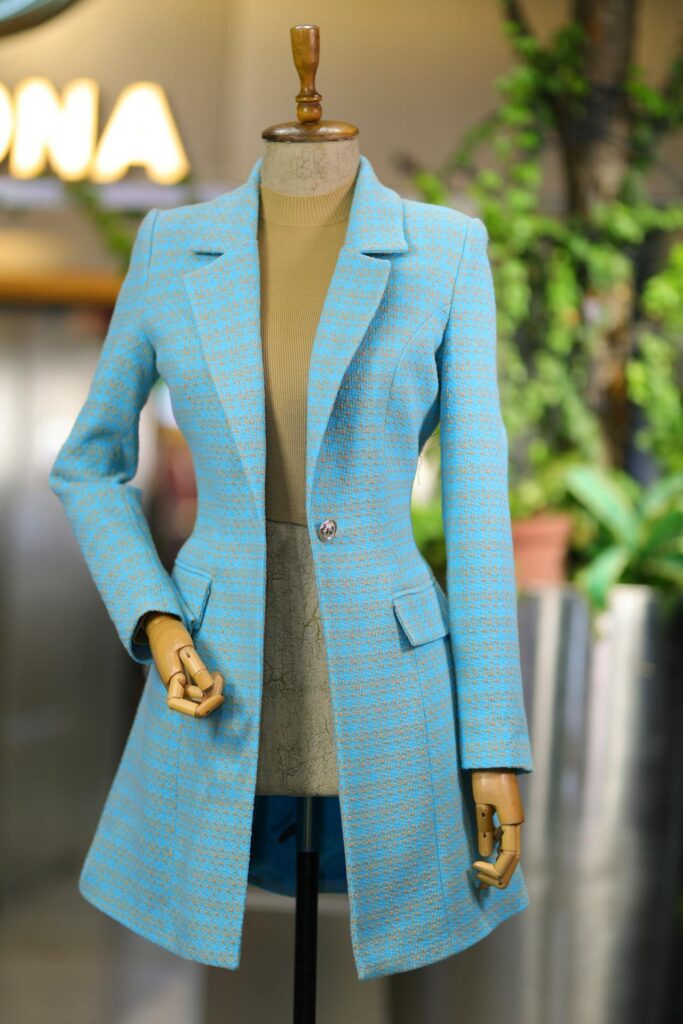
Trench coats are also more detailed and military-inspired. Meanwhile, overcoats tend to be simpler by design with a clean, streamlined silhouette. They have minimal detailing, with a single or double-breasted closure. In addition, they tend to be made from heavy wool or wool-blends focused on insulation rather than weather resistance.
Overcoats are more suitable for formal or professional settings, and tend to have a longer length with a straight or slightly tailored cut, with straight or slanted welt pockets.
When Did Trench Coats Enter Women’s Fashion?
Whilst built to withstand wartime conditions, the trench coat transitioned seamlessly into civilian life after World War I. However, in the 1940s and 1950s, the influence of Hollywood cinema played a pivotal role in encouraging women to embrace the trench coat. Specifically, it evolved from practical outerwear to a symbol of refined sophistication and cinematic allure.
For example, on-screen legends like Marlene Dietrich, Lauren Bacall, and Audrey Hepburn gave the trench coat a new identity. It became a garment of intrigue and allure. Whether worn cinched at the waist over a cocktail dress or draped over the shoulders, it symbolised both independence and elegance. In “Breakfast at Tiffany’s,” Hepburn’s beige trench remains one of fashion’s most enduring cinematic moments.
But as women’s fashion evolved, so did the trench.
The Modern Trench Coat in Womens’ Fashion
From the mid-20th century, luxury fashion houses like Dior, Max Mara, and Yves Saint Laurent began reimagining the trench coat for the feminine form. By the 1960s and 1970s, designers reinterpreted the trench with feminine cuts, shorter lengths, and lighter materials.
- Epaulets and gun flaps were softened or omitted.
- The silhouette was streamlined and belted higher to emphasise the waist.
- Single-breasted versions emerged, offering a cleaner, more minimal look.
- Fabrics expanded beyond gabardine to include twill weaves, silk blends, and lighter cottons, lending the coat seasonal flexibility.
Today, a women’s twill trench coat is a versatile piece. It adds sophistication, structure, and edge to both casual and semi-formal looks.
FAQs
Are trench coats formal?
Trench coats occupy a polished yet semi-formal place in dress codes. High-grade cotton gabardine and wool twill versions convey elegance suitable for business and refined daywear, pairing well with a pair of luxury loafers. However, overcoats remain the standard for true formalwear, especially when worn over suits, tuxedos, or evening wear.
What does a trench coat symbolise?
Trench coats symbolise strength, resilience, and understated elegance. Popularised by icons like Audrey Hepburn and Humphrey Bogart, trench coats bridge military utility with sophisticated urban style.
Why is it called a trench coat?
Named during World War I, the trench coat was designed for British officers using Thomas Burberry’s innovative, water-repellent gabardine—solving the problems of heavy, non-breathable outerwear in trench warfare.
What is twill fabric in coats?
Twill is a diagonal-weave textile known for durability, drape, and subtle texture. In coats, it resists wrinkles, enhances structure, and creates a refined surface ideal for elegant outerwear. Depending on the fibre content—whether cotton, wool, silk, or a blend—twill can vary in its texture and handle, ranging from crisp and smooth to softly brushed or robust.

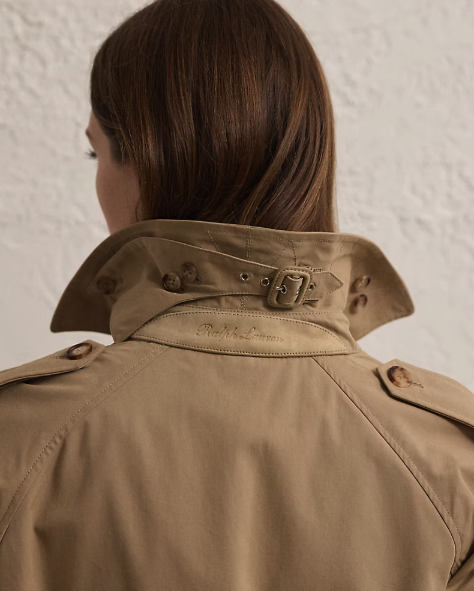
Leave A Comment